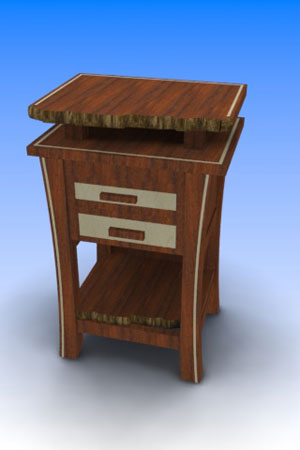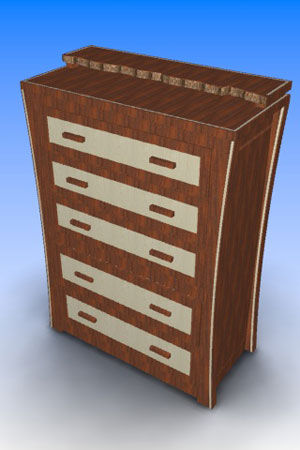
Styles of Woodworking
In his editorial in the last eZine, Rob mentioned his sartorial style (or lack thereof…), and asked eZine readers to share their favorite style of woodworking. At least one reader was prompted to respond in verse. – Editor
“Mission is magnificent,
Greene and Greene sublime.
Stickley was an artist,
Other Mission makers fine.” – Drew Hession-Kunz
Several others mentioned the Mission/Arts and Crafts style as a favorite, too. – Editor
“My preferences are post and beam construction and Mission style furniture.” – Rick Corbitt
“My current favorite woodworking style is stuck between campaign and Mission.” – Rob Casey
“The coolest style is Craftsman.” – Gene Hanson
Some admitted that their favorite style choice was not so much for aesthetic reasons, but for tapping into a style they felt fit their skill level. – Editor
“Most of my projects are some flavor of the Mission/Stickley or Shaker styles, largely because their simple joinery and mostly straight lines are well-suited to my skill level. Fortunately, my wife likes those styles, too.” – Henry Burks
“I prefer Mission. My wife prefers Colonial/primitive. She rules the house, guess what we have? Actually, Colonial/primitive is much easier to build than Mission.” – Ron Geer
“As a beginner – and as someone who owns a house built in the late 1800’s – my personal taste leans styles with relatively simple lines (‘fewer fiddly bits!’), where the wood is allowed to speak for itself. But I like seeing details of a great many styles, since each has things to teach me.” – Joseph Kesselman
“I work in a lumberyard in Alberta, Canada. I am the estimator. I like reading about all kinds of woodworking. Personally, my workshop is tiny — so I like building small items. If I can’t carry it under my arm — well, it takes a long time for me to build it. My wife sometimes get frustrated. But she sure likes it at Christmastime when I give her a fancy turned or handcrafted box with jewelry inside. So keep up the good work. The articles help to get my mind off the blueprints.” – Ron Portas
“Shaker is my most favored, perhaps because my skills aren’t sufficient for some other styles, but also because furniture in the Shaker style seems to me to showcase American hardwoods especially well. I might better say Shaker-influenced; to me, not every genuine Shaker piece has the grace imbued in the works of many of today’s masters who work in that tradition. I’ve had about enough of Mission, Arts and Crafts, etc.; all that murky oak stuff.” – Harlow Chandler
Still, for all the people who voted for easy, simple, clean lines, there were others who appreciated the more decorative styles. – Editor
“My favorite style is Art Nouveau. Yeah, my life would be a lot easier if I preferred a ‘clean’ style, like Shaker or contemporary, but I like Art Nouveau, which entails a lot of carving and ‘funny’ joinery.” – Barry Saltsberg
“Shaker for its simplicity. Art Nouveau for its outrageousness.” – Bill Houghton
“My favorite style: Federal! I can look at a Chippendale highboy and Seymour furniture for hours and mull over how they spent so much time on every detail: bellflower inlays, hidden drawers, and curly maple that looks like it’s on fire! I’m surprised by how much is written on Mission and Shaker pieces but not Federal. I suspect it’s because Federal furniture is so big and complicated. I love a good challenge and can’t wait until my skills (and shop) are up to the task.” – Chris Manocchia
Others made different choices. – Editor
“Nothing beats woodturning!” – James Yarbrough
“50s Modern.” – Jan Slomski
“I had to think a bit about ‘my style.’ I do love the Mission and Shaker styles. And even Art Deco, but I guess that 50’s Modern, or Danish as some love to call it, is where I see my woodwork heading. I think that Sam Maloof and even [James] Krenov are big influences on that. I am a huge fan of the architect Frank Lloyd Wright, but his furniture does not truly move me. I am, however, investigating some of his lamps for some upcoming projects.” – Greg Williams
“The first thing that came to my mind by reading the short clip on the opening email was: The best style is the one you don’t have to do! If I have to do a project to repair or to make something new, it becomes a chore or work. It is even worse if it comes from the ‘honey do’ list. The kind where I just want to do at the pace I want to go, or if I mess up I can do it over, that is the best style.

“After reading the rest of the question, I would have to vote for Colonial of any kind. What was made by the first craftsmen of this country is fabulous. They didn’t have the factories or production work of England; it was started with just a few hand tools.They didn’t have the selection of wood as did England, but they made do with veneer and different techniques. Everyone should go to Williamsburg Virginia to see where it all started. The most wonderful work to me is the way they used wood and paint to look like marble. I say ‘God bless the USA!'” – Kevin Elswick
Like that last comment, many readers just liked woodworking. Period. They either didn’t have, or didn’t know how to label, their favorite style. In fact, one reader would like others to tell him what his style is. – Editor
“I can’t really pick just one kind of woodworking. I love the smell of sawdust and enjoy trying to replicate pictures of everything. I feel in love with woodworking in the 8th grade in school. I had a thing for making stuff, weather it was turning a bowl or making a gun rack. As of late, I enjoy making toys, especially for my grandson. The only thing I regret is not taking pictures of all my projects. I don’t make much to sell, I just give it away. But if I had to pick just one thing, I guess I would pick woodturning. It is just something about watching a piece of wood turn from a block of wood to a plate, bowl or hand toy.” – Michael Edwards
“I’ve been building furniture for many years and have built all kinds. I think what I like the best is the challenge of designing a piece to fit whatever my customers request.” – Ron Robillard
“I don’t know what to call my style. I have made things for other people to their style preference, but when it comes to what I like best, I can’t figure out what to call it. I am beginning to work on a bedroom set for myself. I learned how to use SketchUp and designed it there. Here are renderings of the nightstand and dresser that I designed. Maybe someone can tell me what style it is.” – Bob Baisley
“Tung Oil” vs. “Tung Oil Finish”
In last issue’s Q&A section, a reader asked about applying shellac over tung oil finish. This led to conversations with a couple of other readers about “tung oil” vs. “tung oil finish.” You would think they would be the same thing. That would not be the case. – Editor
“If [the reader who asked the original question] can’t get the gloss he wants from tung oil finish, he’s doing something wrong. I’m also a turner, and tung oil finish is used extensively as a finish on bowls. It’s applied with a rag or paper towel, and lightly sanded between coats to take off the dust nibs. The more coats you apply, the higher the gloss. I’ve finished bowls using Minwax® Tung Oil Finish that gleam like a jewel.” – Barry Saltsberg
Barry, thanks for your feedback. One of the problems the fellow is experiencing is that he is using a Minwax product called Tung Oil Finish that is not pure tung oil. In fact, it has a good amount of mineral spirits and a couple of other chemicals. – Rob Johnstone
“Rob, I just read your response about shellac over tung oil. The reader’s question was about Minwax Tung Oil Finish, which is not tung oil. Tung Oil Finish is typically a mixture of oil, varnish and mineral spirits. In fact, the MSDS [Material Safety Data Sheet] for Minwax Tung Oil Finish states that it is 65 percent mineral spirits by weight. This should be clarified: Tung Oil ‘Finish’ is a very abused name for commercial finish products and should not be considered to have the same properties as an actual tung oil finish. Your response (and Chris’s) seemed to reaffirm to the reader that the ‘Tung Oil Finish’ was, in fact, tung oil. – Steve Perrigo
Thanks for your note. I am aware that the Minwax stuff is a blended finish. I was careful to call it tung oil finish in each sentence. The advice stands for both regular tung oil and the Minwax product. The Minwax product, because it is has a thinner and a hardener in the mix, actually cures faster than tung oil. But to avoid confusion (which I apparently failed to do), I gave an answer that works for either finish. – Rob Johnstone
“Thanks for the reply. I see now that your response can be read either way. Summing it up, a ‘tung oil finish’ is either: (1) a finish comprised of tung oil, or (2) a commercial product that contains other ingredients (and may not even contain any tung oil). In practice, the latter should be probably referred to as “Tung Oil Finish” (with caps) which would denote that it’s a product, just like Chris used with ‘Zinsser’s SealCoat.™'” – Steve Perrigo






